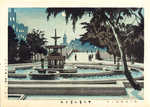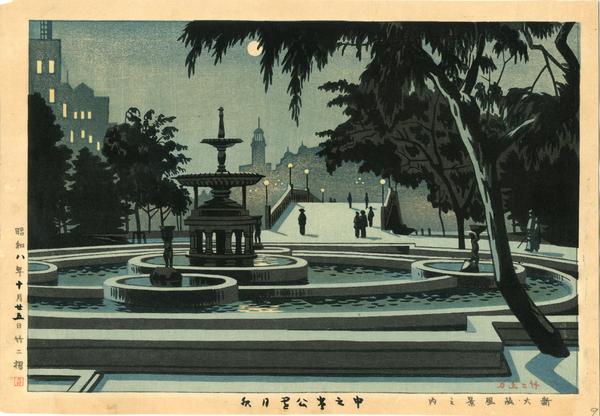| | |
| Artist: | Asano Takeji — 浅野竹二 |
| Title: | Autumn moon over Nakanoshima Park — 中之島公園秋月 |
| Series: | New Osaka Views |
| Date of first edition?: | 25/10/1933 |
| Publisher (first edition)?: | Not Set |
| Publisher (this edition)?: | Not Set |
| Medium (first edition): | Woodblock |
| Medium (this edition): | Woodblock |
| Format (first edition): | Oban
|
| Format (this edition): | Oban |
| DB artwork code: | 46277 |
| Notes (first edition)?: |
From Osaka Prints:
Description: Nakanoshima Kôen geshû (Autumn moon over Nakanoshima Park: 中之島公園秋月) from the series Shin Osaka fukei no uchi (Series of new views of Osaka: 新大坂風景之内)
Signature: Takeji tô (carved by Takeji: 竹二刀) at the lower right of the image; Takeji suri (printed by Takeji: 竹二摺) in the lower left margin
Seals:
Artist Seal: Asano (浅野)
Publisher: No seal (self-published)
Date: 10/1933
Format: (H x W) Ôban nishiki-e
26.1 x 36.8 cm
Nakanoshima (中之島) is a narrow sandbank in Kita-ku, Osaka city, Japan, that divides the Kyû-Yodo River into the Tosabori and Dôjima rivers. During the Edo period Nakanoshima was the heart of Osaka, where all the rice-storage warehouses were located, symbols of the city's economic strength. Today's Osaka city fathers are trying to recapture Nakanoshima's significance by placing numerous cultural institutions there, including governmental and commercial offices (e.g., the city hall of Osaka), and museums, along with Nakanoshima Park (中之島公園).
There are eight known images in the series Shin Osaka fukei no uchi (Series of new views of Osaka: 新大坂風景之内). Asano's view of Nakanoshima Kôen geshû (Autumn moon over Nakanoshima Park: 中之島公園秋月) is an exercise in capturing atmosphere and light. Western influence is evident, particularly in the use of shadows, although the tradition of rendering modern landscapes and cityscapes with a concern for the effects of light can also be traced back to Kobayashi Kiyochika (1847-1915). Even the style of providing titles in the lower margin, read right to left, can be found in the earlier artist's works. Reflections, shadows, silhouettes, and natural and artificial illumination all play a role in this lyrical view of Nakanoshima Park. This is one of Asano's most desirable scenes, a fine example of his undervalued pre-WWII oeuvre. |
|
| Notes (this edition)?: |
| The following information was taken from the original web listing of this artwork. Note that there may be some inaccuracies:
Thanks to Fran Walker for this example. |
|
| Artist Bio: |
Asano Takeji was born in Kyoto in 1900 and studied art in his youth. He graduated from the Kyoto City School of Fine Arts in 1919 and subsequently from the Kyoto City Specialist School of Painting in 1923. One of his early teachers was the artist and printmaker Tsuchida Bakusen, with whom he studied Japanese-style painting. Asano helped to organise the Kyoto Creative Print Society (Kyoto Sosaku-Hanga Kyokai) in 1929.
In 1930, Asano contributed several designs to a series of prints titled "Creative Prints of Twelve Months in new Kyoto" (Sosaku-hanga shin Kyoto junikagetsu). These prints were published by Uchida. The other artists contributing to this series were Benji Asada and Tomikichiro Tokuriki, also members of the Kyoto Creative Print Society. Asano's work as a shin hanga print designer continued throughout the 1930's, but along the way he learned the skills of carving and printing. This enabled him to create his own self-carved and self-printed series of landscape prints titled "Noted Views in the Kyoto-Osaka Area" (Kinki meisho fukei) in 1947.
During the 1950's, Asano designed numerous landscape prints for the publisher Unsodo. These popular landscape prints are still being reprinted today. Original Unsodo prints have the Japanese date printed in the margin, while the modern reprints lack the date. Inspired by the encouragement of the Lithuanian-American social realism artist Ben Shahn, who once visited him in his studio and remained his friend, Asano established a freer artistic style often featuring animals in bold colours, later in his career. Asano continued to work as a printmaker during the 1970's and 80's. These late prints were simple and often humorous, signed with the letters T.A. and the date.
This information has been excerpted from various web sources and from Merritt and Yamada's Guide to Modern Japanese Woodblock Prints: 1900-1975.
浅野 竹二(あさの たけじ、明治33年(1900年)10月24日-平成10年(1998年)2月10日)
京都の日本画家、版画家。京都市立絵画専門学校で日本画を専攻、途中油絵に手をそめましたが、再び日本画に復帰、土田麦僊の率いる「山南塾」に入塾し、国画創作協会展に出品するなど日本画家として活躍しました。 |
|





